ROMAIN OTT BLAZES NEW PATHS IN CHÂTEAU LÉOUBE VINEYARDS: IS THAT CAB FRANC GROWING IN PROVENCE?
by Susan Manfull
In 2002, five years after acquiring Château Léoube, owner Sir Anthony Bamford approached the estate’s winemaker, Romain Ott, with a radical proposition: what if, for one cuvée, we dispensed with regional tradition and introduced the first red Bordeaux-style blend to Provence? Success would require time, patience and the uniquely talented hand of Ott, but the idea of using Cabernet Sauvignon, Cabernet Franc, and Merlot presented a thrilling opportunity to distinguish Léoube as an innovator in a region historically synonymous with rosé. Ultimately, it would take Bamford and Ott nearly a decade to create a wine that satisfied their unwaveringly high standards and the result – Léoube Collector – is a masterful achievement.
A Little Background
In search of a “nice property by the sea” not far from their native Britain, Lord Bamford and Lady Carole Bamford looked along the Côte d’Azur. They found Château Léoube, a drop-dead gorgeous estate consisting of 560 hectares (1384 acres) and occupying four kilometers (2.5 miles) of pristine Mediterranean shoreline. They acquired it, the largest privately owned coastal property on this famous stretch of the Mediterranean, in 1997.
Though not originally seeking a vineyard, Lord Bamford quickly realized what they had come to own. “I’m not a winemaker, but I feel there is something exceptional here,” Lord Bamford noted.
Although grapes had been grown on the estate since the Roman era, years of neglect under the previous owner had left the vineyards in precarious condition—together, the Bamfords resolved to restore Léoube’s former esteem and become a leader of environmentally-sustainable viticulture and winemaking in Provence.
As owner and Chairman of JCB, one of the world’s largest construction equipment manufacturers, Lord Bamford could secure ready access to tractors to develop the estate; Lady Bamford supplied expertise in organic and sustainable farming, as the owner of Daylesford Organic Farm & Farmshops, a health-oriented franchise composed of retail stores, cafes, a cooking school, vacation cottages, a spa, and a charitable trust.
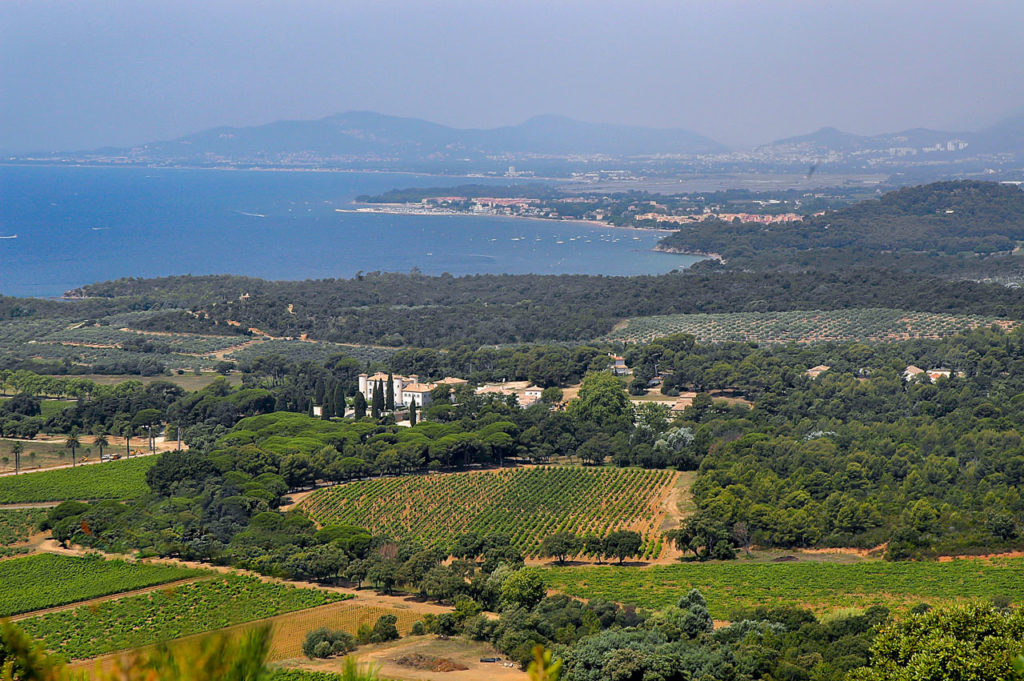
Château Léoube estate. Photo by Pamela O’Neill.
At Château Léoube, the Bamfords were fortuitously situated next to Clos Mireille, one of three Domaines Ott properties, and soon met Jean-Jacques Ott, third-generation descendent of that renowned French winemaking dynasty. Read a longer version of this serendipitous intersection of lives in an earlier PWZ article; suffice to say here, they were able to engage Jean-Jacques Ott to advise on matters of viticulture and viniculture at their newly acquired property. Son Romain Ott joined the effort in 2000, having just completed his studies in oenology at Ecole Supérieur d’Agronomie in Montpellier a mere three days earlier. He had expected to work at Léoube just for the summer, before beginning an apprenticeship at a winery in the United States, however, when his father later asked him to oversee the harvest at the end of the summer, Ott couldn’t resist.
From roughly 2000 to 2008, work focused on rebuilding the vineyards, fortifying good vines and removing poor quality vines. Preparing soil and (re)creating terraces to ensure proper drainage and exposure entailed a conscientious attention to detail and perseverance for which only the most ardent have the patience. Work also commenced in the winery to completely renovate it and install state-of-the-art equipment. In the meantime, only small quantities of wine were produced, sold in bulk for local consumption.
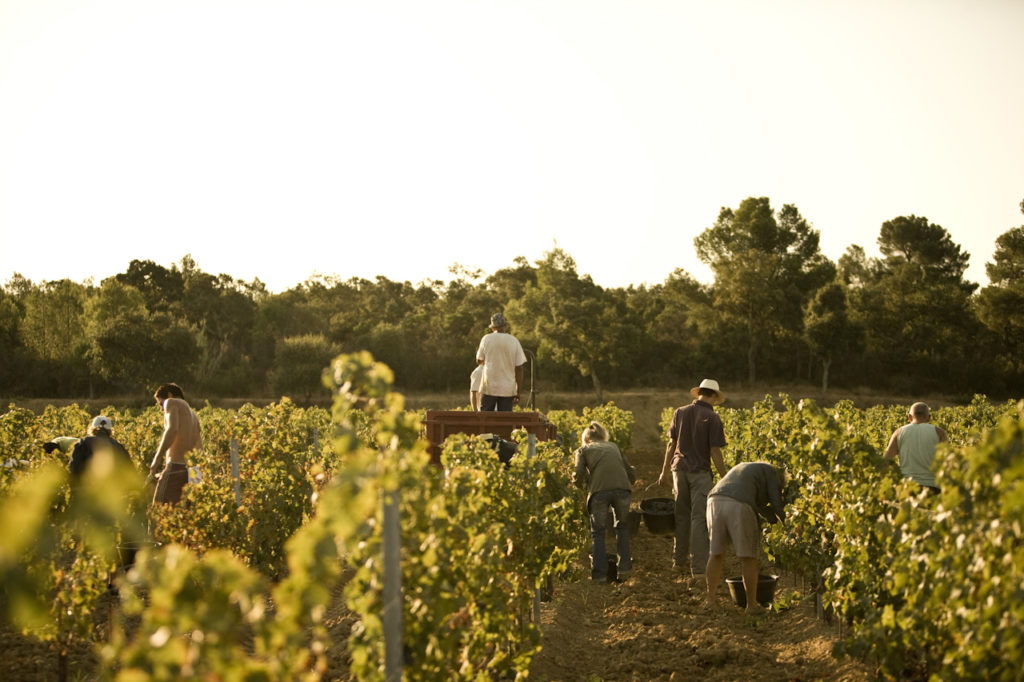
Château Léoube vineyards. Used with permission by Château Léoube.
In 2008, eleven years from the time the Bamfords purchased the property, the inaugural bottling of wine worthy of the Bamford-Ott legacy and Léoube label finally occurred.
Jérôme Pernot, Sales and Marketing Director at Château Léoube, emphasized that nothing was rushed in the early days of rebuilding the vineyards (and this is still very much the case today). “A huge investment of time is made [because] in the long run, the vines will produce much better grapes for a longer time,” Pernot said. When I toured the property in July 2015, Pernot identified vineyards undergoing reconstruction and explained that preparing the soil takes about five years after which time grapes are harvested for three to five years to create compost and make bulk wine. It can take ten years from the time work on the land commences until the new vines begin to provide grapes that will make wine worthy of the Château Léoube label.
Romain Ott’s Mission
Having just ascended to senior winemaker when his father (semi) retired around 2002, the younger Ott was tasked with a mission: to produce a red wine that could showcase Léoube and exemplify the height to which that color of wine could rise in a region world-renowned for its rosé. Even for an agricultural engineer who specialized in oenology—and was part of the fourth generation of Domaines Ott winemakers—this assignment must have seemed formidable. After all it came from Château Léoube owner Lord Bamford, lover of fine wines and a man with impeccably high standards. And, at the time, Ott had only just finished his oenology studies two years earlier.
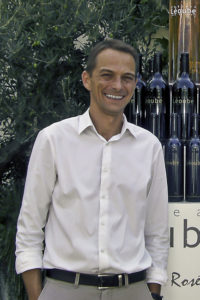
Romain Ott, Oenologist at Château Léoube Photo by Pamela O’Neill
“I was excited,” Ott told me in a recent telephone conversation. “Yes, it [felt] challenging but I heard [the goal] and understood it was a target for the future.” Another young winemaker might have been quaking in his field boots, but Ott said that it felt great to be working with someone like Lord Bamford who had such vision for the future of the estate.
Back in 2002, when ideas for what would come to be called Léoube Collector were still incipient, the Château was not yet producing any wine that met the high standards set by the Bamfords or Otts.
As the story goes, the inspiration for this mission originated with Lord Bamford’s observation that the latitude of Château Léoube (43.15°) was right around that of Bordeaux (Saint-Émilion is 44.88°) and Tuscany (Livorno is 43.55°), the latter being where the acclaimed “Super Tuscans” are made. The primary grape varieties used in both the Bordeaux blends and Super Tuscan blends are Cabernet Sauvignon, Merlot, and Cabernet Franc. However, in the Côtes de Provence, only one of these varieties is approved by the Appellation Contrôlée system (France’s quality designation system) for inclusion in red wines that fall into the highest classification, AOP (Appellation d’Origine Protégée). That singular grape is Cabernet Sauvignon, a rarely grown “secondary” variety used exclusively for blending purposes. In the Côtes de Provence, the principal grape varieties approved for use in AOP red wines are Syrah, Grenache, Mourvèdre, Cinsault, and Tibouren.
Appellation regulations notwithstanding, why, Bamford wondered, couldn’t the varieties typically used in Bordeaux and Tuscany be grown in Provence to produce something just as magnificent? Ott began with a small tank of Cabernet Sauvignon from a few hectares of 20-year-old vines already growing on the property, but found this first batch “drier” than desired, referring (I believe) to the drying sensation in one’s mouth due to the strong tannins typical of Cabernet Sauvignon.
The widely exalted Cabernet Sauvignon is the progeny of the Cabernet Franc and Sauvignon Blanc—not the parent of either.
Ott explained to me that they wanted a cépage “different from Léoube’s normal range but [still] in the style of Léoube.” Something not too heavy, with concentrated flavor, balance, smoothness (“velvet on the mouth”) and a long finish. Mouthfeel, Ott said, is particularly important: “the beginning and the end must be linked by the mouth.”
“Cabernet Franc can be smooth and balanced, rounder than Cabernet Sauvignon,” Ott said, which led the Ott to recommend planting three hectares of Cabernet Franc as well as one hectare of Merlot and a little more Cabernet Sauvignon.
For nearly ten years, as the vines grew older, Ott carried out “small tests to see which style of wine could be produced at Léoube,” focusing on the three grape varieties and endeavoring to imagine what would be the right mix to create a truly exceptional red wine. Ott said this wine would be designated as Vin de France, the lowest of the three appellation classifications because of the non-AOP grapes they have chosen to use. The quality had to be very high. “The best wine we have,” he added.
Vin de France
“We are the only Provence vineyard with Cabernet Franc,” Pernot confirmed in a recent conversation.
Why? The answer, as is inevitably the case in French winemaking, centers on meeting the meticulous criteria to be deemed an AOP wine, traditionally held in highest regard and what most winemakers strive to produce.
In France, wines are classified into one of three categories. Aside from the eminent AOP classification (formerly AOC, short for Appellation d’Origine Contrôlée), the two other categories of wine are generally less prestigious; however, they allow the winemaker greater freedom in selecting which grape varieties to plant (as well as, for example, sourcing the grapes and determining the proportions of each variety that go into the cépage, deciding the vinification techniques, and establishing the style of the wine). The second tier of designation, called IGP (Indication Géographique Protégée) or its former name, VDP (Vin de Pays), generally refers to wines from a broader area than a given appellation. The bottom tier, Vin de France (formerly called Vin de Table), refers to wines that are subject to minimal regulations but are usually held in low regard.
A great many Vin de France wines are unremarkable at best though very inexpensive. They are typically produced from high-yielding vines, often from varieties that happen to be plentiful on the estate. Many are packaged in ‘bag-in-box’ containers, widely known as cubi boxes, to further reduce costs.
Because Cabernet Franc is not on the list of permissible grapes for a wine designated as AOP Côtes de Provence—nor is it permissible in any appellation in Provence—the wine that would come to be called Léoube Collector would be designated Vin de France.
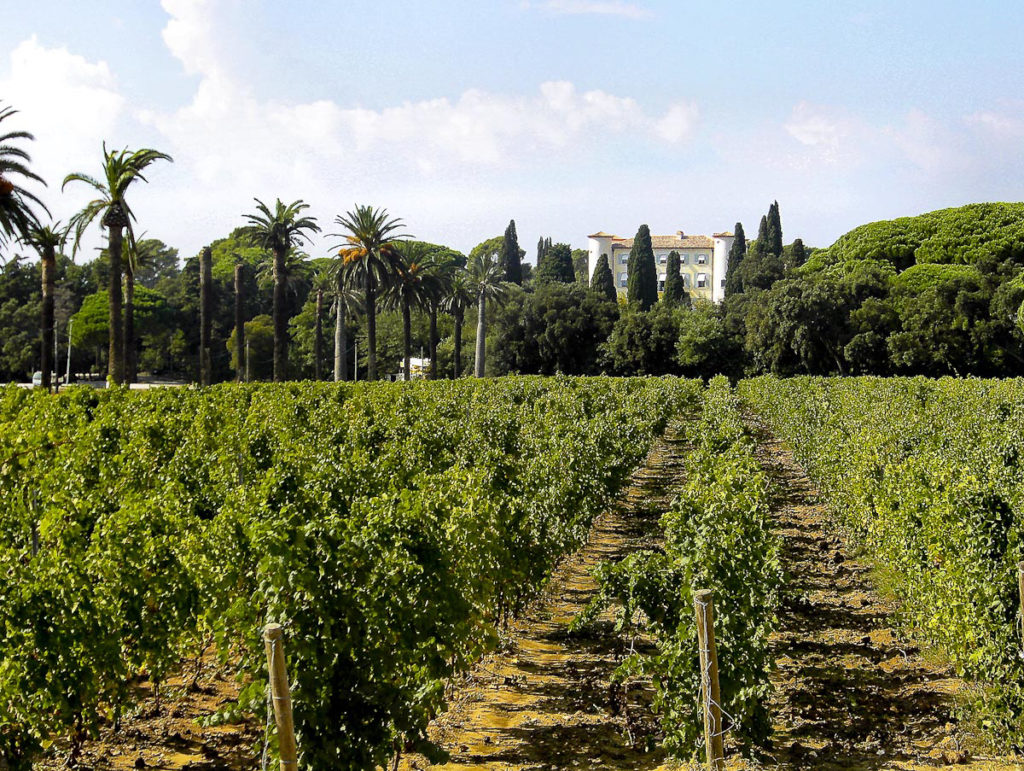
Château vineyards seem to lead right to the Château. Photo by Pamela O’Neill.
Devoting prime vineyard space on Château Léoube’s property to a non-conforming grape (actually two, including Merlot) in order to experiment with the creation of a wine in the lowly Vin de France category, especially in a relatively inchoate estate—it was barely five years into their ownership—might be viewed as unrestrained. However, when the Bamfords purchased the estate, only 40 hectares (just shy of 100 acres) of the 560-hectare (1384-acre) property were allocated to grapevines. Clearly, there was some wiggle room in the expansion plans. My guess is that the Bamfords and the Otts relished the opportunity to dabble with grapes foreign to Provence. It seems to me that Lord Bamford wanted to push the envelope and Romain Ott was just as eager.
Apart from appellation regulations, however, growing Cabernet Franc at Château Léoube made good sense. The grape is one of the 20 most widely grown in the world. According to The Oxford Companion to Wine, Cab Franc was the sixth most planted black grape variety in France throughout the 20th century and in 2011, it accounted for approximately 40% of the vines in the southwest, about 25% in the Loire Valley and environs, and about 12% in Bordeaux.
In Bordeaux, where Cabernet Franc reaches its pinnacle in the form of Saint-Émilion’s Château Cheval Blanc single varietal Cabernet Franc wine, universally considered one of the world’s greatest wines, that grape is more widely planted. In Château Cheval Blanc, Cabernet Franc dominates the vineyard: fully two-thirds of this vineyard is devoted the Cabernet Franc variety with the remaining third left for the (generally more dominant) Merlot vines.
Cabernet Franc is generally thought to grow best in cool climates, such as in Bordeaux and the Loire Valley, where it has historically thrived. As it turns out, the climate of Bormes-Les-Mimosas, where Château Léoube is located, is not as remarkably different as you might expect from that found in those two regions. The average annual temperature hovers around 54° F with a range of about 58 degrees in both of these regions. The average annual temperature in Bormes-Les-Mimosas is just a little warmer at 58° with slightly more variation, about 62 degrees (on average). In Livorno, Tuscany, the average annual temperature is also 58° with about the same amount of variation as in Bormes-Les-Mimosas. Interestingly, in the western Pyrenees of Spain, where Cabernet Franc may have originated, the average temperature profile is remarkably similar to this part of Provence. Notable, higher monthly temperatures prevail along the Mediterranean and in Tuscany more than in either the Loire or Bordeaux (or in its alleged place of origin). Most notable, the average number of hours of sunshine annually seems to especially set Provence apart from the other locations: With close to 3000 hours of sunshine each year, Bormes-Les-Mimosas has over 1000 more hours than the Loire, nearly 1000 more than Bordeaux, and roughly 700 more than Livorno. There are four months in which the average monthly temperature exceeds 77° F in both Provence and Tuscany, compared to two months in Bordeaux and Loire. The lowest monthly temperatures are about the same across these four Cabernet Franc-growing areas. Precipitation is much lower in this part of Provence or in Tuscany. Anything beyond this cursory (and unscientific) look at climate such as diurnal temperature variation or factors such as soil composition, elevation, topography, aspect, proximity to water, etc.—that is, terroir—surpasses the scope of this article; this nerdy paragraph is included in case another nerdy person shares my curiosity about the possible logic for planting a grape varietal no one else was planting (and still isn’t).
Bottom line is that adding a few hectares of Cabernet Franc (and Merlot) to the mix was not a big gamble, especially for a proprietor with an expansive domain, deep pockets, and an apparent affinity for adventure.
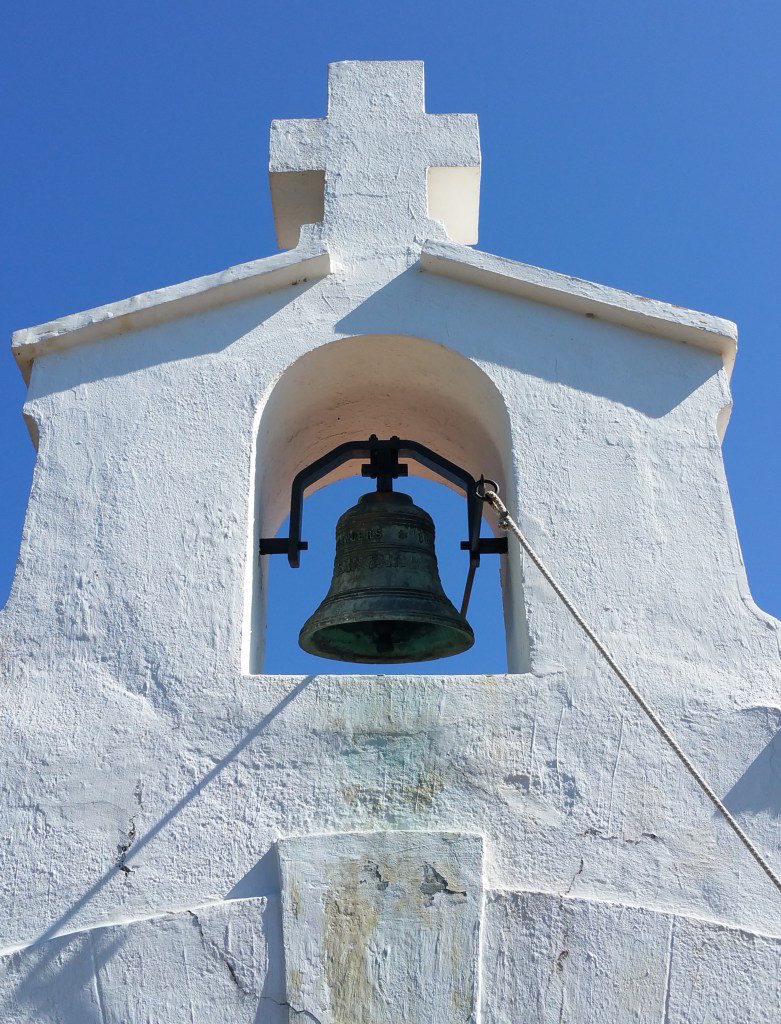
Chapel St George (10th century). On the Léoube Collector bottle (as well as other Léoube bottles, look just below the name, on the right side, to find a small cross; it was inspired by the one on this chapel that graces the Léoube property. Photo used with permission from Château Léoube.
Bamford and Ott are part of an increasing number of winemakers across France that have not sought a given wine’s AOP status (or relinquished it) in favor of the freedom offered by the Vin de France classification. Some of these wines are as good as, if not better than, the top AOP wines. Like Bamford and Ott, most winemakers who retreat from the appellation system do so in order to use grape varieties not allowed under appellation regulations. Liberated from the onerous AOP system, these winemakers can fully express their own version of their beloved craft, often producing wines that come to be their flagship cuvées.
The rogue approach has well served Eloi Dürrbach of Domaine de Trévallon fame in Saint-Etienne-du-Grès near Saint-Rémy-de-Provence. When AOC regulations changed in 1994, Dürrbach chose to flee the appellation system in order to continue making his moitié–moitié wines of Cabernet Sauvignon and Syrah that he contends match the terroir of Les Baux. “Rather than betray the personality of its wines,” in the words of the domain’s website, this legendary winemaker produces IGP wines. The long list of accolades and voluminous amount of space in the literature devoted to exceptional reviews are a testament to his transcendent success. To be clear, his wines are neither unremarkable nor inexpensive.
To get an exceptional Vin de France wine to stand out from pack, a reputation associated with quality—of the wine, the winemaker, and the estate—is critically important (although their higher price tags are also a good indicator of their premium quality). Echoing Ott’s sentiments above, when winemakers opt to produce a Vin de France wine, it the best wine of the estate.
The First Vintage: Léoube Collector 2011
Over the years and across the many assemblage sessions, the focus had begun to narrow to a single varietal cuvée of Cabernet Franc. In 2011, as Ott tells the story, the vintage looked to be a good one for reds, “so we produced a small cuvée of Cabernet Franc.” By this time, work had been completed two years earlier in the winery—it was fully renovated and state-of-the-art—which undoubtedly would contribute to cajoling the best wine from those grapes! The results were indeed good, according to Ott so they continued.
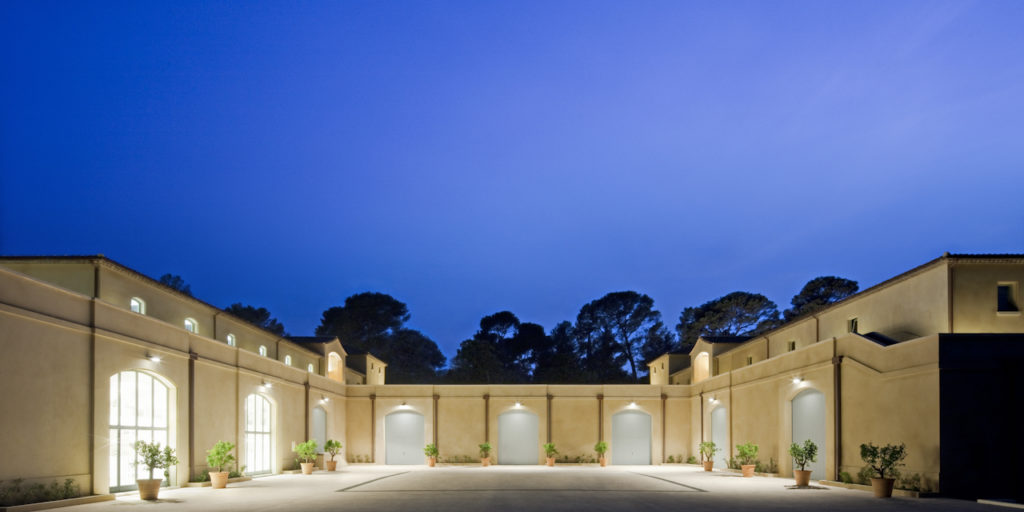
Château Léoube Tasting Room and Vinification Center. Photo used with permission from Château Léoube
Finally, nearly ten years after beginning the project and planting the vines, the 2011 vintage met the high standards of the Bamford-Ott duo and it happened to be 100% Cabernet Franc.
Pernot told me that their intention was certainly not to make a single varietal red and that it is entirely conceivable that a little Cabernet Sauvignon and/or Merlot could be added in the future. (Read on for more on this subject.) Cabernet Franc would always be the dominant grape.
The harvest of Cabernet Franc takes place in September, the exact time determined by Ott based on the usual indicators of maturity such as sugar, acidity, alcohol, and phenolic compounds (e.g., tannins). Because a small percentage of the Cabernet Franc parcel is allocated to producing Sparkling de Léoube, which is made mostly of Cabernet Franc, and is picked earlier, Ott has a direct reading of maturity when that harvest occurs. As with all harvests at Château Léoube, grapes are manually harvested and sorted by hand; in the case of the Collector, they are then destemmed. Then, it’s into the stainless steel tanks for a slow maceration (about three weeks, Ott told me) followed by natural alcoholic fermentation, and later malolactic fermentation in 600-liter medium-toasted French oak casks (demi-muids). The wine is aged for 18 to 24 months, considerably longer than the typical 9-month aging period of the other two Léoube red wines.
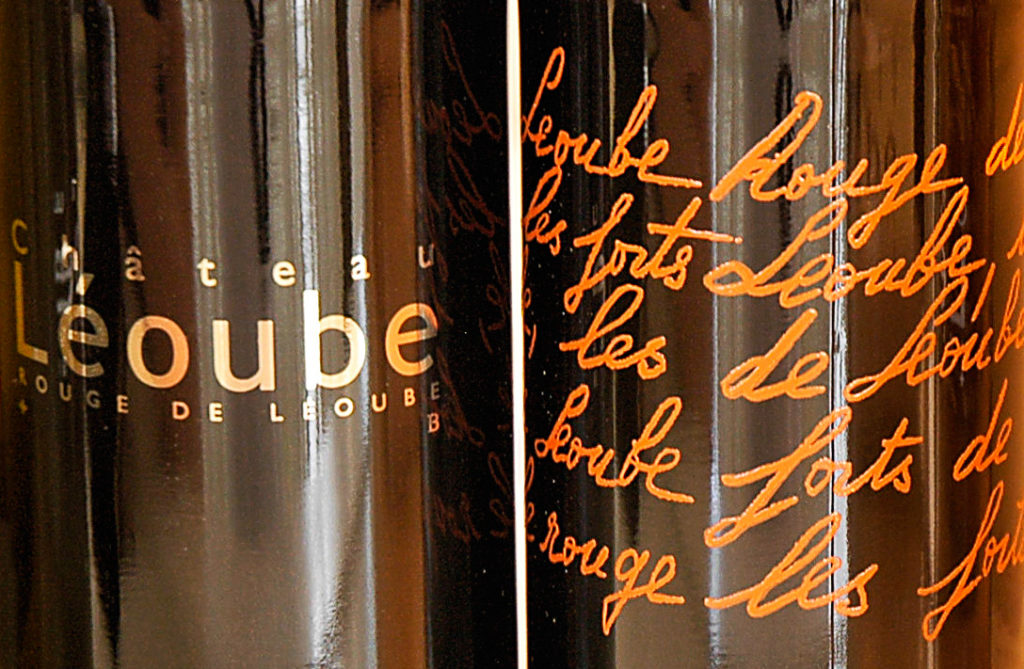
Château Rouge de Léoube and Les Forts de Léoube. Photo by W. T. Manfull
By the time the first Léoube Collector was bottled and out, the two other red wines in the Léoube portfolio were in their fourth vintage. Was Collector “clearly different in style to the red wines currently showcased in the Léoube portfolio,” per the directive of Lord Bamford? I had the pleasure of tasting this vintage when visiting the Château in July 2015. My notes tell me that it was very pleasing and definitely different than either Château Rouge de Léoube or Les Forts de Léoube, the other two reds. Bigger than the other reds but simultaneously elegant, well-structured. I detected blackberries on the nose that continued on the palate, coupled with faint notes of dark chocolate and a bit of leather. Most notable was the mouthfeel which was pleasing, velvety though slightly more tannin than I expected. I envisioned game or lamb as accompaniments that would soften those tannins but I will never know as I did not purchase a bottle and now it is sold out.
Was the mission accomplished? Did Ott succeed in producing a red wine that could showcase Léoube and exemplify the height to which that color of wine could rise in a region world-renowned for its rosé? My humble palate suggested that it wasn’t quite there yet. Then, along came the second vintage.
The Second Vintage: Léoube Collector 2012
Last month, we invited a few wine-loving folks over for a small Cabernet Franc tasting and dinner. The real goal was to taste and enjoy the recently released 2012 Léoube Collector but being the geeky hostess I am, I subjected my friends to one of my instructive sideshows, comparing the single varietal Cabernet Franc Collector with another Old World wine and a New World wine, each consisting of different amounts of the star grape. With none of the relevant variables held constant (e.g., vintage, grapes, region, etc.), it was impossible to draw conclusions but we were unequivocal in our clear preference for one of the wines.

The tasting trio of Cabernet Franc wines. Photo by W.T. Manfull
The New World example was a 2009 Dry Creek Valley (Northern Sonoma County) wine from the Jones Vineyard of Merriam Vineyards; it was predominantly Cabernet Franc (95%) with Cabernet Sauvignon making up the rest. The Old World was represented by a 2007 Saint Émilion Grand Cru from Château Lassègue; the blend was 68% Merlot, 25% Cabernet Franc, and 7% Cabernet Sauvignon.
We decanted the Collector 90 minutes ahead of our gathering, a judicious decision as it took about two hours for this incredibly interesting wine to fully open up. We began our tasting sans nourriture (without food).
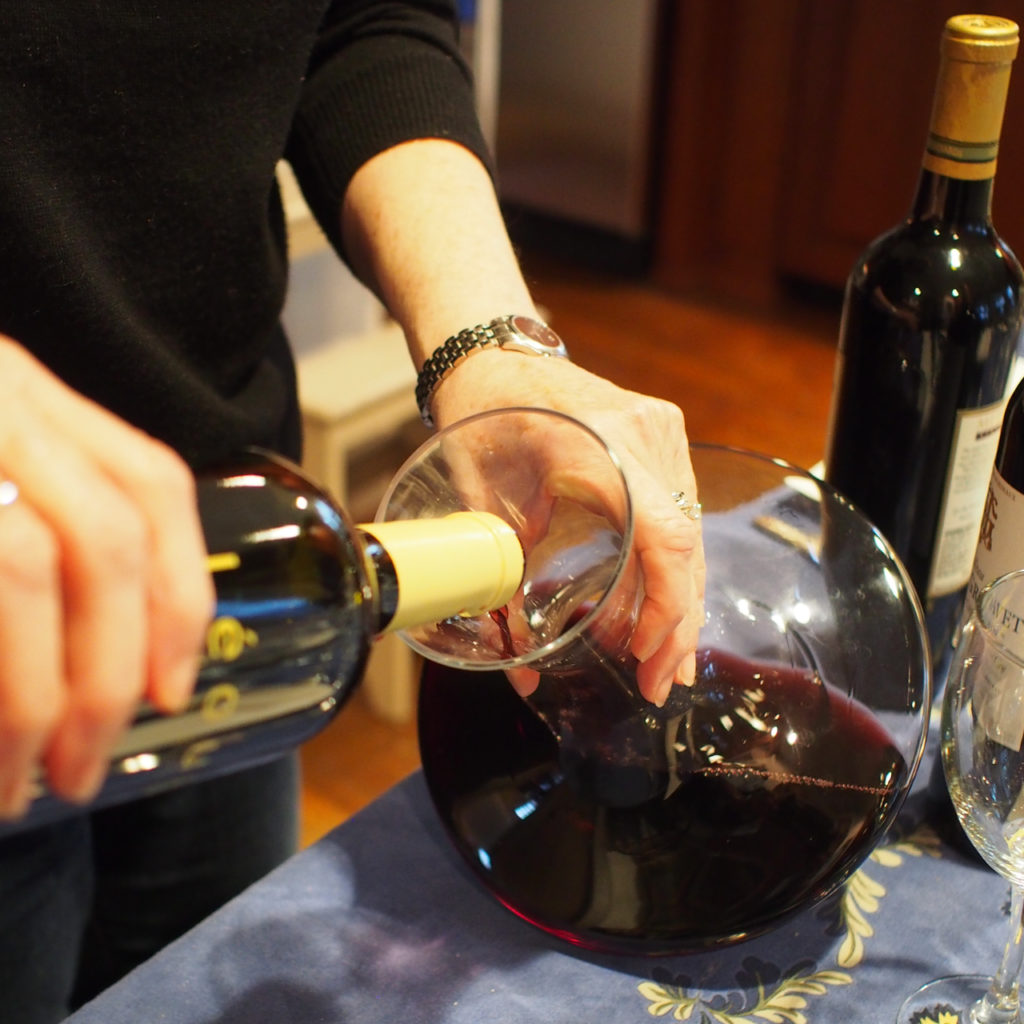
Decanting Léoube Collector. Photo by W.T. Manfull
Although Léoube nose was slow to awaken, it was fabulous when it did. Layer upon layer of aromas wafted from the glass, bringing to mind blackberries, plums, red and black currents with whiffs of tobacco and garrigue. On the palate, the dark fruit flavors persisted; notes of earthiness or umami and vanilla, tobacco were detected, with a little spiciness. Medium body, well-balanced, good structure, and perfectly integrated tannins and alcohol. The finish was long, finessed, and exceptionally pleasing. What is most striking about this wine is its incredibly silky mouthfeel, emphasized by all tasters, and its seamless flow from nose to finish, “like a wonderful melody,” suggested to one taster. Elegant, refined, graceful, it quietly commands a presence at the table.
“Il ne faut pas que le vin casse le repas ou le repas casse le vin.” Ott said in a telephone conversation.
When the first course of dinner was served, we were bowled over by how this wine cozied up to Bifteck Marchand de Vin served with Auguste Escoffier’s classic steak sauce and Crêpe de la Pomme de Terre, creating new flavors and sensations. One taster said that the fruit flavors of the wine were much more pronounced when the Collector was married with food.
In sum, as one veteran taster put it, “I would tell the winemaker not to change a thing!” Powerful words for a Vin de France wine.
In a later conversation with Pernot, he confirmed our distinct impressions that Collector is crafted in an Old World style, characterized by balance with no singular element standing out. Harmonious, indeed.
“Drinking a bottle of Léoube wine is about being with friends and food,” Pernot said, adding “We expect the bottle to be empty at the end of the night.”
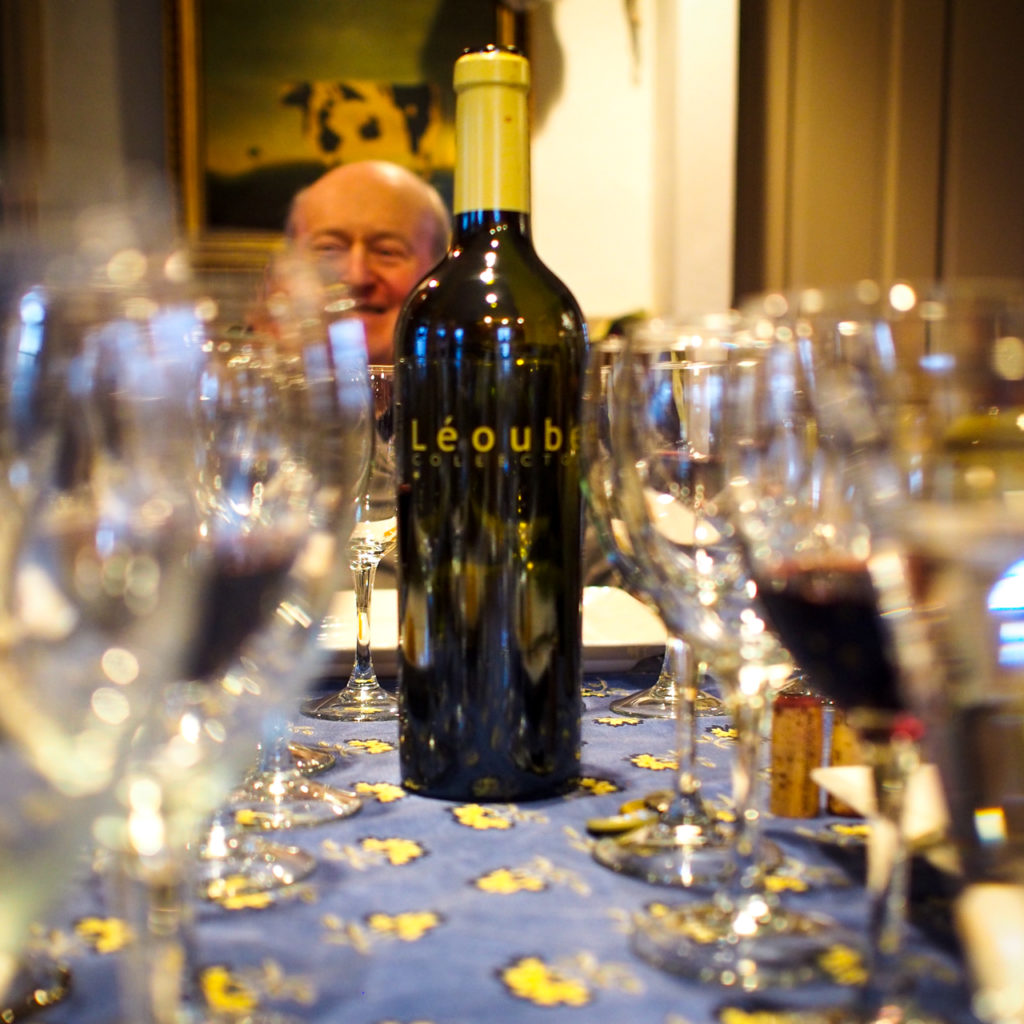
Château Léoube Collector takes center stage. Photo by W.T. Manfull
Not so with New World wines; a little goes a long way. The Merriam Vineyards wine was initially a standout with its immense bouquet, flavorful palate, and decent finish. However, its 14.9 % alcohol dominated the experience, leaving one feeling satiated quickly. With food, this wine seemed combative.
The Château Lassègue wine was lackluster and cumbersome, even when we later decanted it, though it paired better with our meal than the Merriam Vineyards did.
We all agreed that we would welcome another bottle of Léoube Collector at our next dinner party but that it would also benefit from some time in the cellar. Ott agreed that it would benefit from aging but said that it was not necessary to age in order to enjoy it. We completely concur: cellar only if you have extra bottles and are curious.
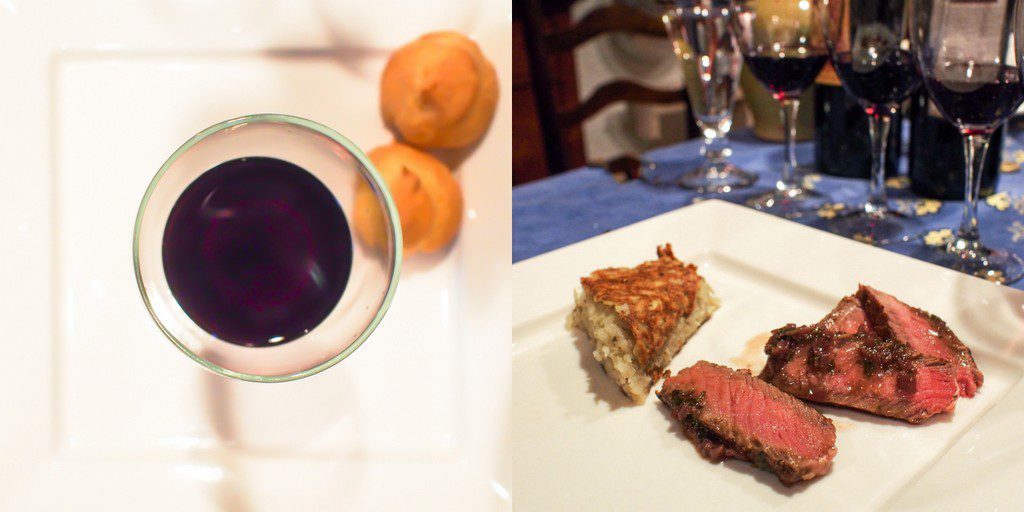
From left to right: A glass of Léoube Collector with gougères; Bifteck Marchand de Vin served with Auguste Escoffier’s classic steak sauce and Crêpe de la Pomme de Terre. Photo by W.T. Manfull
“We make wines so they are already drinkable,” Ott explained, “The aim is to have wine to age if you want, but it’s perfect now [too].”
“It’s difficult for me to wait, except for exceptional wines,” Ott laughed. “I want to appreciate it now.”
This is a limited production wine: 8,000 bottles were filled and about 5000 are left at the Château. It’s not clear how many bottles will be shipped to the U.S., perhaps as few as 600. The price is about $59 (in the U.S.), €42 (at the Château),and £45 (at Daylesford Organic Farm & Farmshops). In the U.S., I’m told that the highly regarded online wine store, Garagiste, will be selling the Collector–sign up now to receive the offer for the Collector, to be shipped in September. Stay tuned for updates.
Looking forward
Ott accomplished the mission with the 2012 Collector. Without a doubt, he created a red wine that will showcase Léoube, joining a handful of other wineries committed to making red wines that soar to great heights in the world’s most famous rosé-producing region, one recognized around the globe as its gold standard bearer. All the more interesting that the Léoube Collector is a Vin de France wine. It will only get better as the vines grow older. The laurels await.
Does the Collector evoke memories of a favorite Bordeaux or Super Tuscan wine? Yes, but the Collector has its own personality. Sharing some of the same DNA only partially explains the final product, a large part certainly but that ol’ terroir magic plays a powerful role here. Made from grapes grown just 300 meters from the sea, factors like salty sea breezes, humidity, and cool nights are in play. The sea once covered the land of this estate some 800 million years ago, leaving in its wake a unique composition of minerally soils, primarily characterized by varying degrees of clay, sand, quartz, and mica schist. The garrigue—rosemary, sage, lavender—that comprise the surrounding scrubland wafts in the air, leaving its mark on the vines. The Provençal sun provides nearly 3000 hours of bright light each year. The temperature averages about 58° annually but on a given day, it can swing quite dramatically. Minimal rain falls in this area but powerful winds, like the famous mistral, can whip across the vineyards, drying them, keeping them free of diseases. These are but a few of the factors that distinguish this microclimate from that of properties in Bordeaux and Tuscany. And then there is the winemaker.
Romain Ott himself is a product of this terroir. Growing up next door, he knows this stretch of the sea and the nooks and crannies of the land, the fragrant scents that perfume the air, and the regional antics of Mother Nature. A fourth generation winemaker, to boot, he is more suited than almost anyone else (except perhaps his father) to intuitively understand how to realize the guiding philosophy of Château Léoube: “Produce the best from what the land can give you with great affection and care.”
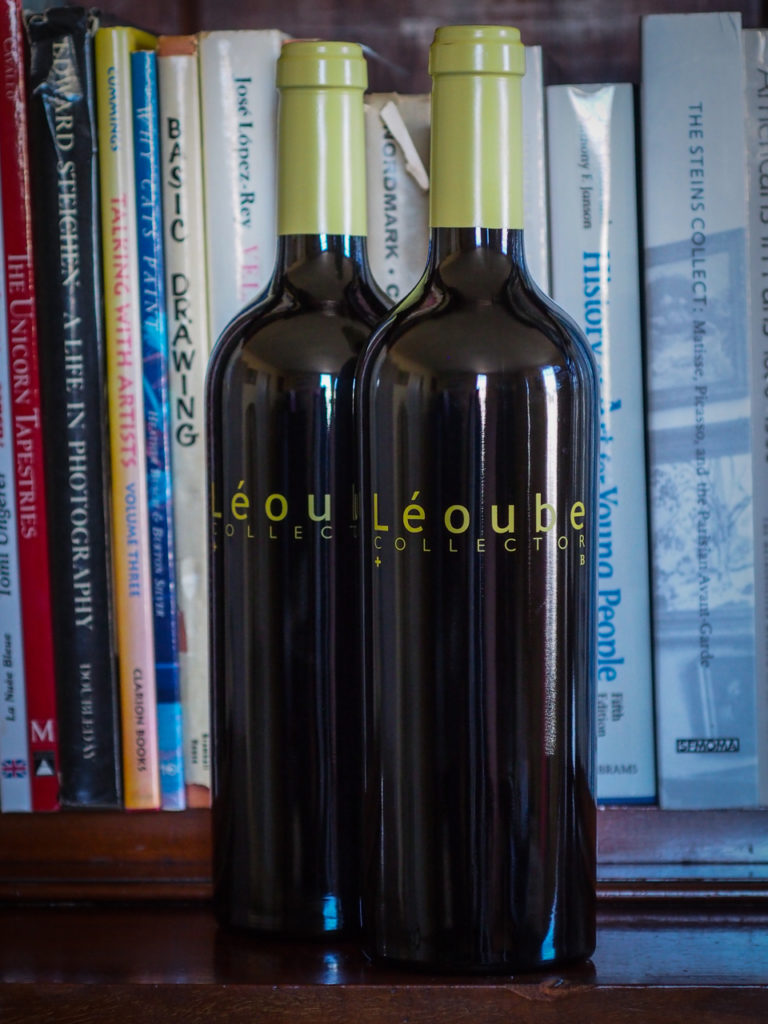
A lovely pair of Léoube Collectors. Photo by W.T. Manfull
As I write, the 2013 Léoube Collector, also a single varietal Cabernet Franc, is bottled and resting in the Château’s cellars. The 2014 vintage is still aging, waiting to be bottled in October or November and, Ott told me, has “a tiny bit of Cabernet Sauvignon” added to the predominantly Cabernet Franc cuvée. The 2015 vintage has finished malolactic fermentation and is clarifying in oak casks now—its particular blend remains to be determined.
The 2014 bottle will feature the Bamford family crest, underscoring that the Collector is the family cuvée. “This is Lord Bamford’s baby,” Pernot told me. Will it be his vinous legacy, too?
It seems there is a growing interest in this grape, both as a single varietal and blended, among vintners and consumers. In France, it is increasingly planted in the southwest. Elsewhere, in Eastern Europe, especially in Hungary, more Cabernet Franc is showing up in vineyards. In North America, it is increasingly grown in California (Napa and Sonoma), Washington, Virginia, New York (in Long Island and the Finger Lakes) as well as in Ontario, Canada. Elsewhere in the New World, it is increasingly planted in Australia, New Zealand, South Africa, Chile, and Argentina. In a 2015 Wine Spectator article entitled “Cabernet Franc’s Time,” Ben O’Donnell writes that this varietal is popping up more and more on wine lists in chic bars and restaurants in Manhattan and, in a recent email exchange, he told me this trend appears to continue into 2016: “I’m definitely continuing to see Cab Franc on lots of wine lists.”
Many people will pull the cork from their bottle of Léoube Collector, decant it (I hope), immensely enjoy it, while having no idea why this wine is so special. Arising from the incipient notion that planting a few hectares of a grape variety alien to Provence could lead to Château Léoube’s flagship wine and, ten years later, producing this exceptional Vin de France cuvée is a story to celebrate. Let’s toast to blazing new paths.
Notes:
All Léoube wines are Ecocert Certified Organic and biodynamic principles guide practices in both vineyard and winery.
Léoube Collector will be available through Garagiste online winestore.

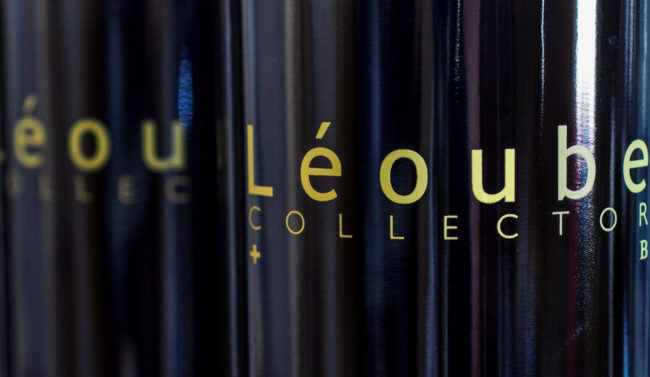
Not just saying this because I’m a born again cheerleader for Léoube wines, I swear, but this is one of your best articles. I especially like the nerdy bits on climate comparisons of Cabernet Franc growing regions. And Susan, I know you have another bottle of Collector lurking in your cellar. Save some for me!
It’s so easy to be a cheerleader for this château, isn’t it! With the number of research and stat classes we have under our belts, we could do a lot more with the climate if we had the data! Thanks for your nice comments — you wouldn’t have ulterior motives…in the shape of a certain bottle, would you?
I shant comment on ulterior motives, though there may be some lurking. I will, however, heartily agree with your tasting notes as I had the pleasure of tasting the new Collector at Château Léoube’s open house this weekend. Plummy, silky, spicey. Even lovelier than last year’s.
I’m glad you got to try it! Heavenly!
Thank you for pointing out the minefield that embodies the French classification system. It seems with Lord Bamford we see another maverick in the making. Looking forward to seeking out Leoube Collector on next visit to the area.
A full post could be devoted to this subject! We just added a new section to the Provence appellation information, detailing the regulations re grapes for each of the appellations…check it out! At the top of the page, the new information is under “resources” and then “wine regions of France,” then click on “Provence.” Thanks for the comment, Jerry!
Great article Susan, as you know it’s a winery close to my own art!!
Hi Caroline! I do know you are a big fan as well! Whe we finally get together, I know there will be a bottle of Léoube at the table–we will just need to settle on the color!
I agree with Pamela – this is a great article. But, from the foodie POV, that steak with the crêpes looked amazing! I think I need that recipe to put on Cocoa & Lavender!
I will get the recipes to you. The crêpes are from “Bocuse in Your Kitchen: Simple French recipes for the Home Chef” by Paul Bocuse (1982), reissued in English by Flammarion. It is indeed simple! the meat, also simple is adapted from Auguste Escoffier’s “Le Guide Culinaire” and was published in “The Week,” a publication I subscribed to quite a few Years ago. Also, pretty simple! Thanks for the kind words!
I simply loved the Léoube. What a treat! Where can we buy another?